Themed collection A collection on dense networks and low-cost sensors, including work presented at ASIC 2022

Performance of Vehicle Add-on Mobile Monitoring System PM2.5 measurements during wildland fire episodes
A universally attachable, lightweight PM2.5 mobile monitor provides reliable and actionable supplemental information on air quality conditions in communities impacted by wildland fire smoke via a nationwide loan program.

Environ. Sci.: Atmos., 2024,4, 306-320
https://doi.org/10.1039/D3EA00170A
A portable sensor for the determination of tree canopy air quality
A low-cost portable sensor system has been developed and described to interrogate individual trees and quantify their impact on air quality (CO, NO2, PM2.5).

Environ. Sci.: Atmos., 2023,3, 1186-1194
https://doi.org/10.1039/D3EA00057E
Highly local sources and large spatial variations in PM2.5 across a city: evidence from a city-wide sensor network in Cork, Ireland
When dominated by local emissions, levels of ambient particulate matter (PM) can vary appreciably within a city. In Ireland, residential solid fuel burning is the main PM2.5 emission source.
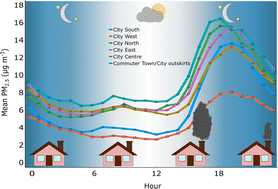
Environ. Sci.: Atmos., 2023,3, 919-930
https://doi.org/10.1039/D2EA00177B
In situ drift correction for a low-cost NO2 sensor network
Frequent collocation and calibration paired with temperature, relative humidity, and ozone correction factors improved the performance of a low-cost NO2 sensor network in Maricopa County, Arizona.

Environ. Sci.: Atmos., 2023,3, 894-904
https://doi.org/10.1039/D2EA00145D
Evaluation of low-cost gas sensors to quantify intra-urban variability of atmospheric pollutants
Low-cost electrochemical air quality sensors can provide deep insights into the intra-urban variability of different air pollutants after proper calibration using field co-location with regulatory Air Quality Monitoring stations.
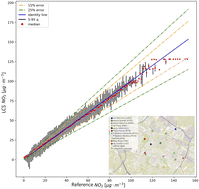
Environ. Sci.: Atmos., 2023,3, 830-841
https://doi.org/10.1039/D2EA00165A
Estimation of hourly black carbon aerosol concentrations from glass fiber filter tapes using image reflectance-based method
Our method measures atmospheric BC concentrations by analyzing photos of particle deposits on glass-fiber filters. Post-analysis of beta attenuation monitor (BAM) tapes collected worldwide can be a valuable source for hourly BC data, particularly for Global South countries.
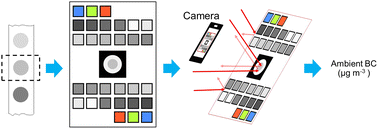
Environ. Sci.: Atmos., 2023,3, 842-854
https://doi.org/10.1039/D2EA00166G
Laboratory and field evaluation of a low-cost methane sensor and key environmental factors for sensor calibration
Low-cost electrochemical methane sensor shows improved measurement accuracy after corrections for carbon monoxide, absolute humidity, temperature, and adjusting for time of day in an urban environment.
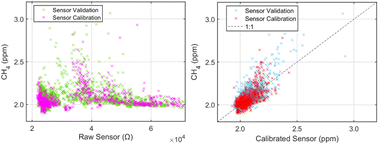
Environ. Sci.: Atmos., 2023,3, 683-694
https://doi.org/10.1039/D2EA00100D
An analysis of degradation in low-cost particulate matter sensors
PurpleAir sensors are widely used to measure PM2.5 levels in cities around the world. However, little is known about the change in sensor performance over time. This paper fills this gap.
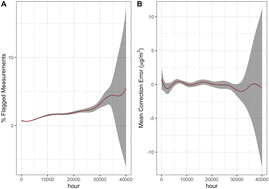
Environ. Sci.: Atmos., 2023,3, 521-536
https://doi.org/10.1039/D2EA00142J
Investigation of indoor air quality in university residences using low-cost sensors
Indoor air quality (IAQ) is crucial for the wellbeing of university students. Yet, IAQ in student residences is highly variable and challenging to monitor. This work is the first to monitor IAQ in student residence with a low-cost sensor network.
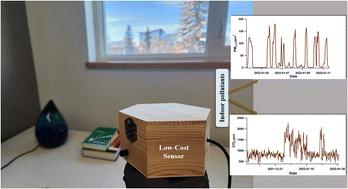
Environ. Sci.: Atmos., 2023,3, 347-362
https://doi.org/10.1039/D2EA00149G
Improving the performance of portable aerosol size spectrometers for building dense monitoring networks
A new charging method is deployed to improve the accuracy of portable size spectrometers with reduced size and maintenance, thus, more suitable for building dense monitoring networks.

Environ. Sci.: Atmos., 2023,3, 338-346
https://doi.org/10.1039/D2EA00163B
Particulate matter in a lockdown home: evaluation, calibration, results and health risk from an IoT enabled low-cost sensor network for residential air quality monitoring
Low-cost sensor analysis of indoor air quality.

Environ. Sci.: Atmos., 2023,3, 65-84
https://doi.org/10.1039/D2EA00124A
Application of machine learning and statistical modeling to identify sources of air pollutant levels in Kitchener, Ontario, Canada
Machine learning is used in air quality research to identify complex relations between pollutant levels, emission sources, and meteorological variables.

Environ. Sci.: Atmos., 2022,2, 1389-1399
https://doi.org/10.1039/D2EA00084A
Ambient characterisation of PurpleAir particulate matter monitors for measurements to be considered as indicative
Using low-cost systems to obtain indicative measurements when no calibration is possible.

Environ. Sci.: Atmos., 2022,2, 1400-1410
https://doi.org/10.1039/D2EA00085G
About this collection
For over a decade the advent of low-cost sensors has promised a paradigm shift in the way air pollution is measured. Although the full potential of these devices may not yet have been realised, a significant amount of work has now been done to demonstrate their capabilities. In contrast to the traditional model of air pollution monitoring, advances have predominantly come from novel software developments instead of hardware.
Guest-edited by R. Subramanian, Albert Presto, Peter Edwards, and Mei Zheng, this collection explores this rapidly developing and exciting area of research, from operating dense networks of devices to enhancing the information content of sensor data and making measurements in previously difficult to access environments (e.g. residential properties).